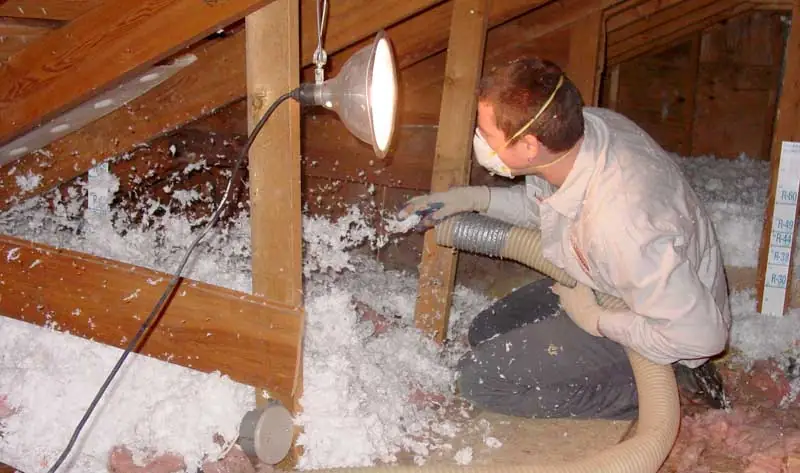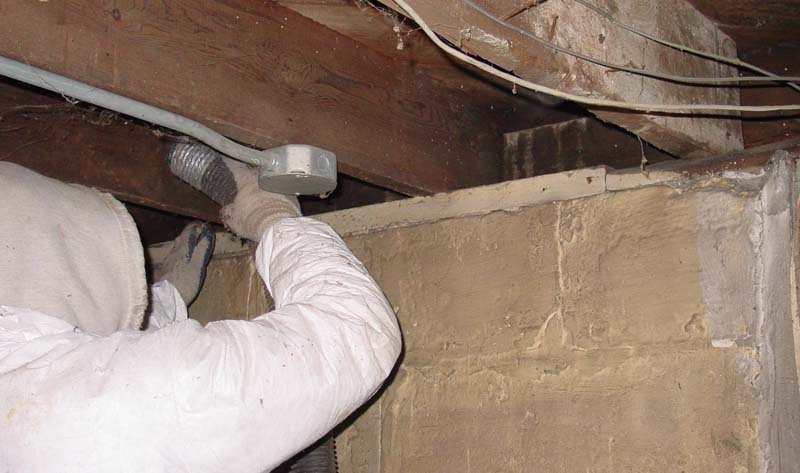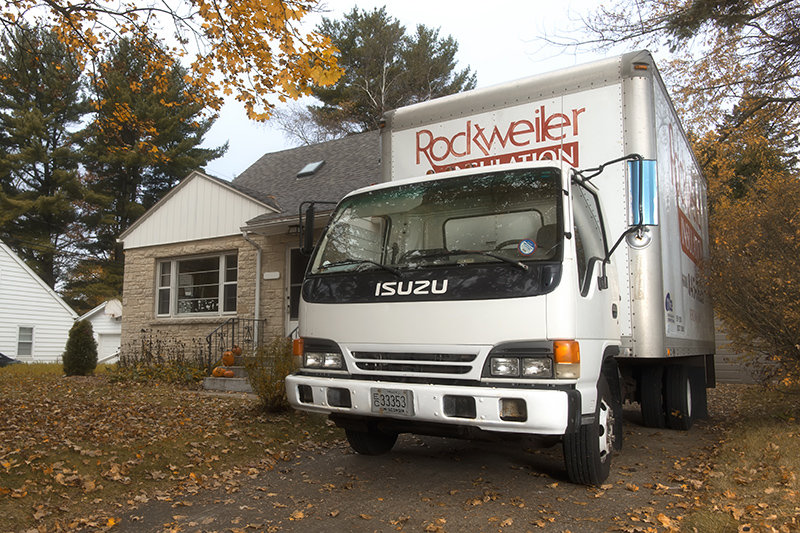Did you know that if you added up all the air leaks in the average home they would be equivalent to leaving a window open all year? That’s a lot of wasted air. And most of that escaping air goes straight through your attic. For homeowners shivering through our cold Wisconsin winters, that often means higher energy bills and lower comfort. That’s why attic insulation is often the first line of defense. But insulation work shouldn’t stop there.
Our climate gives us warm and wet summers and frigidly cold and snowy winters. To make it through every Wisconsin season, it’s important to create a comfortable and energy-efficient home. And the most effective way to reach that goal is with a whole-home approach. Both older and newer homes can benefit from adding proper insulation and air sealing from top to bottom, not only in the attic, but the walls, basement, and crawl space too.
Attic Insulation – Necessary but Not Sufficient
Let’s start with the attic. Heat naturally rises in winter. If your attic isn’t sealed and insulated, that warm air escapes through your roof leaving your home chilly. But with proper attic insulation and air sealing you can lower your heating and cooling costs by an average of 15% and even help prevent ice dams. But many homes, especially older ones, are under insulated.

According to Wisconsin’s building energy code, unfinished attics should have R-49 of attic insulation (although the 2021 International Energy Conservation Code (IECC) recommends up to R-60). That translates to about 15-20” of loose fill insulation. Blown-in fiberglass insulation can also be added over undamaged existing insulation to reach the right R-value. This is the ideal place to start, but stopping with your attic means you leave other leaky parts of your house vulnerable and open to continued energy loss. You’ve got more money and energy to save, so don’t stop there!
Wall Insulation – The Drill & Fill Advantage
Your exterior walls are another major source of heat loss if not properly insulated. Older Wisconsin homes, especially those built before the1970’s, may have little to no wall insulation. This can cause cold spots even after improving your attic.
That’s where the “drill and fill method” comes in. Insulation can be added to your exterior walls through this highly effective process. A piece of your home’s exterior siding is removed, and a small hole is drilled in the exterior wall. Then either cellulose or fiberglass insulation is dense packed into the wall cavity, the hole is sealed, and the siding replaced. This can also be done from the inside of your home during remodeling. A home with 2×4 walls can hold approximately R-13 to R-15 of loose-fill insulation.
When combined with air sealing, this insulation solution creates a solid thermal barrier in your formerly empty walls so you can enjoy less drafty rooms, more consistent comfort, and even bigger energy savings to accompany your insulated attic.
Basement Box Sills – The Hidden Heat Leak
Look down and you’ll find another area of your home that’s often overlooked: the basement. Specifically, the box sills. Your basement’s box sills are found around the edge of your basement ceiling where the joists meet the wall of the basement. It’s one of the thinnest points in your home’s exterior and a major source of heat loss and cold air infiltration.

Sealing and insulating your basement box sills along with your attic helps stop the chimney effect where cold outside air is drawn in through the cracks in your basement rim joists to replace the warm air that’s been pulled up and out through your attic roof. This leaves you with cold, drafty floors and higher energy bills.
There are several popular ways to insulate box sills, such as cutting and fitting rigid foam board insulation to each rim joist and then sealing the edges. Fiberglass batts are also often used to insulate rim spaces, but fiberglass doesn’t seal air leaks. The gold standard for insulating basement rim joists and reducing heat loss is spray foam insulation. Closed-cell spray foam seals and insulates in one step, with an R-value of R-6 to R-7 per inch. It creates an airtight barrier and provides excellent moisture resistance for your basement. Remember that even a small 1/4” crack in a rim joist can leak significant cold air. Look to seal these small cracks (1/4” or less) with caulk while larger cracks (1/4” to 3”) need spray foam for the job. Then you can enjoy warmer floors and less cold air slipping in from your basement.
Benefits of Whole-Home Insulation
When you take care of these three critical problem areas (your attic, walls, and rim joists) together, you’ll start enjoying many benefits:
Lower energy bills
Less heat escaping means your furnace works less in winter and your AC runs less in summer, giving you significant savings in total energy costs.
Increased comfort

Eliminate cold spots, drafts, and ice-cold floors. Enjoy more consistent temperatures, while stopping the chimney effect.
Healthier and quieter home
Insulation combined with air sealing can help keep dust, pollen, and unwanted pests out of your home. Dense packed walls and an insulated attic help block outside noise, creating a more peaceful space.
Durability and moisture control
Enjoy reduced mold potential thanks to better humidity control, and less summer air condensation on cool basement surfaces. You’ll have a more durable house with fewer maintenance issues.
Local incentives
Plus, Wisconsin’s Focus on Energy program offers rebates to help cover the costs of energy saving projects and products, including attic, wall, and basement box sill insulation. Check often for current cash back opportunities.
Remember: Don’t Only Look Up!
Yes, while your attic is a critical piece of maximizing your home’s energy efficiency, it’s doesn’t complete the puzzle. To have a truly comfortable and energy-efficient home, you need to go beyond the attic, with a whole-home approach. Add effective insulation materials to your walls and basement box sills too for a well blanketed home from top to bottom.
Professional installation is your best path to a well-insulated and air sealed home. Homeowners throughout the Madison area and beyond have turned to our trusted team at Rockweiler Insulation since 1983. We are your local insulation expert and have decades of experience with evaluating homes, consulting on tailored insulation solutions, and installing long-lasting insulation and air sealing products.
Are you ready to improve your Wisconsin home’s energy efficiency and comfort? Contact us today to insulate and air seal your home from the ground up.
References
Energy Star. (n.d.-a). Why Seal and Insulate? Retrieved November 2025, from ENERGY STAR website: https://www.energystar.gov/saveathome/seal_insulate/why-seal-and-insulate
Energy Star. (n.d.-b). Sealing Air Leaks: Basement. Retrieved November 2025, from ENERGY STAR DIY Guide: https://www.energystar.gov/saveathome/seal_insulate/do-it-yourself-guide/sealing-air-leaks-basement
Focus on Energy. (2024). Insulation – Reducing Energy Waste Across Wisconsin (Fact sheet). Retrieved from https://focusonenergy.com/
North Dakota State University Extension. (2008, December 11). Rim Joists Can Be Source of Energy Loss. Retrieved from https://www.ag.ndsu.edu/news/newsreleases/2008/dec-11-2008/rim-joists-can-be-source-of-energy-loss
U.S. Department of Energy. (2025, April 1). Where to Insulate in a Home. Energy Saver – Home Weatherization. Retrieved from https://www.energy.gov/energysaver/where-insulate-home
Wisconsin Historical Society. (n.d.). Insulating the Attic of Your Historic House. Retrieved November 2025, from https://www.wisconsinhistory.org/Records/Article/CS4206
Building Science Corporation. (2017). Critical Seal (Spray Foam at Rim Joist) (Information Sheet 408). Prepared for U.S. Dept. of Energy Building America Program. https://www.energystar.gov/sites/default/files/asset/document/BSC%20Information%20Sheet%20408%20Critical%20Seal%20%28Spray%20Foam%20at%20Rim%20Joist%29.pdf



